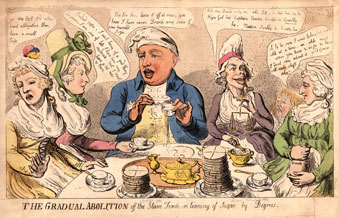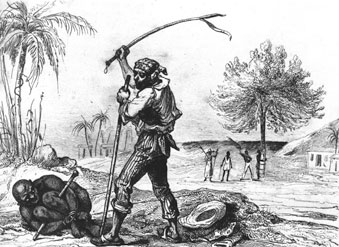
The 1807 Slave Trade
Abolition Bill, passed by the British Parliament on 25 March,
ended the use of British ships and the involvement of British
merchants in the slave trade. Slavery continued in the British
Empire until 1834, followed by a four-year period of enforced
apprenticeships, described by critics as ‘slavery
in all but name’. Enslaved men, women and children were
finally given their full freedom on 1 August 1838.
The 1807 bill was a significant step towards total abolition
and came about through a combination of factors including resistance
by enslaved Africans and the campaigning of abolitionists, both
black and white.
Key dates in the build-up to the passing of the bill include:
1761
Quakers banned people engaged in the slave trade from being
members of the Society of Friends. While some churches, notably
the Church of England, upheld the slave trade, many non-conformist
Christians, including the Quakers and Methodists, stood against
it, emphasising that everyone was equal in the eyes of God.
1772
Granville Sharp successfully defended James Somerset, a
Virginian slave who had run away from his master during a visit
to Britain. The landmark judgement in the British courts declared ‘no
master ever was allowed here to take a slave by force to be sold
abroad because he deserted from his service’. This meant
it was illegal forcibly to remove an enslaved person from Britain,
although, in practice, runaway slaves continued to be recaptured
and sent back to the colonies.
1773
Enslaved poet Phillis Wheatley from Boston visited London
with her owner’s sons and astonished influential people
with her talent, making them question long-held beliefs about
the intellectual inferiority of black people that had helped
justify slavery.
1781
Over 100 captive Africans were thrown overboard from the
slave ship Zong so the owners could claim compensation from the
insurers. The case came to court, drawing public attention to
the evils of the trade.
1783
The Society for the Abolition of the Slave Trade was founded.
Granville Sharp was its first president. The society decided
it was impractical to abolish slavery itself but concentrated
on banning the trade. It was felt this would bring an end to
the wars in Africa that were fought for the purposes of enslaving
captives, stop the horrific Middle Passage voyage across the
Atlantic of the slave ships and encourage plantation owners to
treat their slaves more humanely as it would be harder for them
to acquire replacements. The society was later headed by William
Wilberforce MP. Wilberforce was a member of the Clapham Sect,
a group of Evangelical Christians closely involved in the campaign
against the slave trade.
1788
Slave Trade Regulating Bill passed, limiting the number
of enslaved people that could be carried on slave ships.
1789
Olaudah Equiano, a former slave, published his best-selling
autobiography and became an important contributor to the abolitionist
campaign, speaking at rallies around the country. Other notable
former slaves in eighteenth-century Britain included Equiano’s
friend Quobna Ottobah Cugoano, Ignatius Sancho, who ran a grocery
shop and wrote poetry and plays, Frances Barber, who worked as
a servant for Samuel Johnson and later ran a school in Lichfield,
and the musician and composer Joseph Emidy who lived in Falmouth.
1789
Wilberforce tabled his first unsuccessful bill to abolish
the slave trade.
1791
A slave revolt on the French colony of St Domingue led
by Toussaint L’Overture developed into a campaign for black
independence. The French surrendered the island in 1804, which
became the independent state of Haiti. There was widespread fear
among British people during this period that the enslaved people
of Jamaica, inspired by the success of the black independence
campaign, would similarly rise up in rebellion – the island
was only a hundred miles from Haiti, within easy reach of ‘undesirable
influences’. Though no British colony did gain independence
in this way, rioting, sabotage and resistance by slaves successfully
disrupted work on the plantations and proved a major incentive
for emancipation.
1792
Resolution for the abolition of the slave trade defeated
in the House of Lords.
1794
Following the French Revolution, slavery was abolished
in all French colonies. It was restored by Napoleon I in 1802.
1801
100 Irish MPs joined the British Parliament, the majority
of whom were opposed to slavery.
1805
Bill for Abolition of the Slave Trade passed in the Commons,
but defeated in the Lords.
Economic forces also played a part. By
the late-eighteenth century, British merchants were already
moving their investments to more profitable ventures and many
Caribbean plantations had closed as a result of competition
from other producers.
A year after the Abolition Bill was passed, the British West
Africa Squadron, part of the Royal Navy, was formed to suppress
slave trading by patrolling the African coast in pursuit of slave
ships. It is estimated that by 1865 nearly 150,000 captives had
been freed in the navy’s anti-slavery operations. This
was not purely a humanitarian effort, but one devised partly
to disrupt the trade of rival nations still using slave labour.
Of the other main colonial powers, the French and Danes freed
their Caribbean slaves in 1848, followed by the Dutch in 1863,
the Spanish between 1870 and 1886 and the Portuguese in 1888.
Slavery was abolished in the US with the Thirteenth Amendment,
passed on 1 January 1865.

‘The leaving of sugar’. Read
more...

Slavery in Brazil. Read more...
|